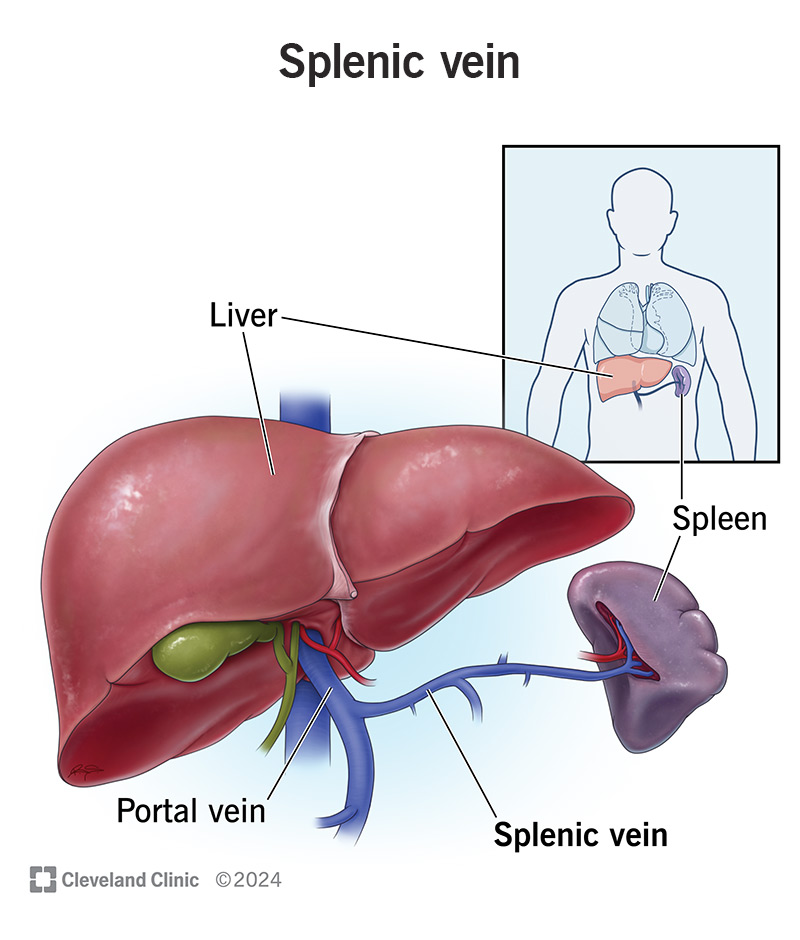Your splenic vein carries blood from your spleen (and other nearby organs) to your portal vein. After passing through your portal vein, your blood passes through your liver for filtering and processing. Then, it returns to your body’s general circulation. Your splenic vein plays an important role in managing blood flow and making sure your blood gets properly cleaned and recycled.
Advertisement
Cleveland Clinic is a non-profit academic medical center. Advertising on our site helps support our mission. We do not endorse non-Cleveland Clinic products or services. Policy

Advertisement
Cleveland Clinic is a non-profit academic medical center. Advertising on our site helps support our mission. We do not endorse non-Cleveland Clinic products or services. Policy
Your splenic vein is a large blood vessel that carries blood from your spleen, pancreas and parts of your stomach to your portal vein. It’s part of your hepatic portal system, which includes your portal vein and mesenteric veins.
Your splenic vein joins with your superior mesenteric vein to form your portal vein. From your portal vein, your blood drains into your liver. There, your liver filters and processes your blood before returning it to your heart for recirculation through your body.
Your splenic vein’s main function is to transport blood processed by your spleen. Your spleen filters out damaged red blood cells, removes certain infectious organisms from your blood and adds infection-fighting white blood cells to your blood. After receiving blood from your spleen, your splenic vein carries it to your portal vein. Your portal vein then moves your blood to your liver for further cleaning.
By transporting this blood to your liver through the hepatic portal system, your splenic vein helps keep your blood healthy. This combined effort is vital for your body to function correctly and receive the right nutrients.
Your splenic vein is in your belly, tucked behind your stomach and near your spleen. It runs from your spleen, which is on your left side under your ribs, toward the middle of your belly.
Advertisement
Various smaller vessels form your splenic vein as they leave your spleen. These smaller veins are called tributaries. Tributaries that empty into your splenic vein include:
The most common diseases or conditions that can affect your splenic vein include problems related to blood flow. Problems with blood flow in your splenic vein can lead to issues with your spleen and nearby organs. Some of these conditions include:
There are several tests and scans your provider can use to check the health of your splenic vein and the diseases it’s associated with. Diagnostic methods include:
Keeping your splenic vein working properly requires lifestyle habits and medical strategies that promote good vascular health. Preventing conditions that can lead to complications like splenic vein thrombosis or portal hypertension will also help.
Here are some general guidelines:
Your splenic artery delivers oxygen-rich blood to your spleen, while your splenic vein takes used blood away from your spleen to your liver for processing. Basically, your artery brings in fresh blood, and your vein carries out your old blood.
Advertisement
If you’re looking into the splenic vein, chances are, you or someone you care about might be dealing with a related health issue. It’s great that you’re seeking information about it. Learning more can make a big difference in managing health challenges. It’s also important to keep talking to your doctors, asking questions and sharing your feelings with them. Being involved in your healthcare is crucial. Taking good care of yourself and staying optimistic is key.
Advertisement
Cleveland Clinic’s primary care providers offer lifelong medical care. From sinus infections and high blood pressure to preventive screening, we’re here for you.

Last reviewed on 09/27/2024.
Learn more about the Health Library and our editorial process.